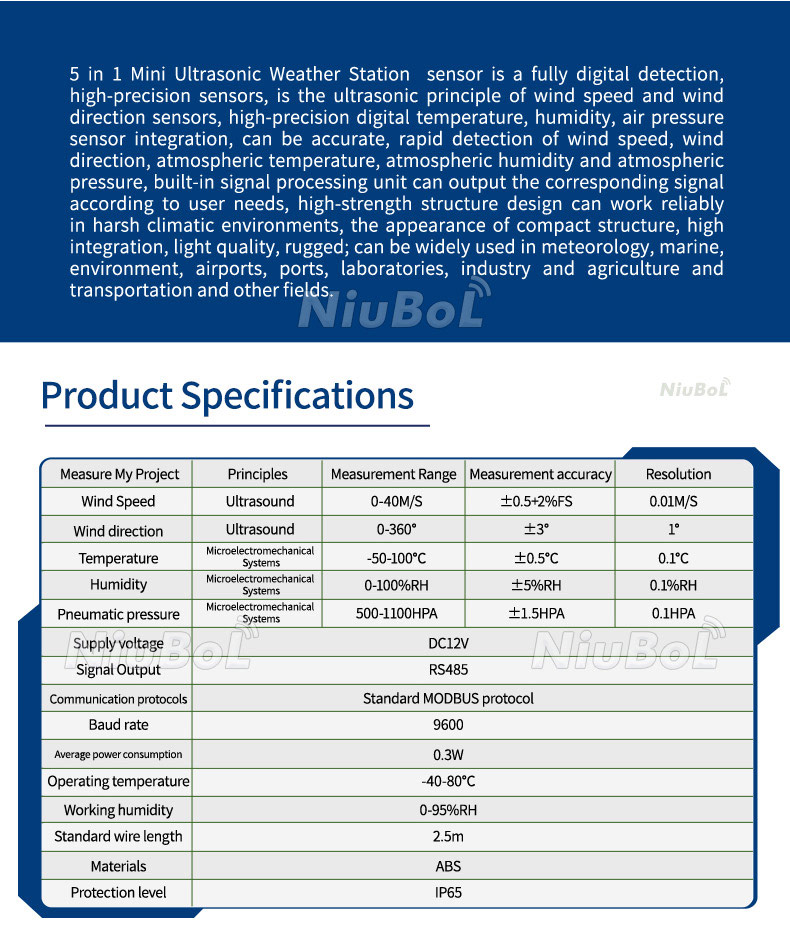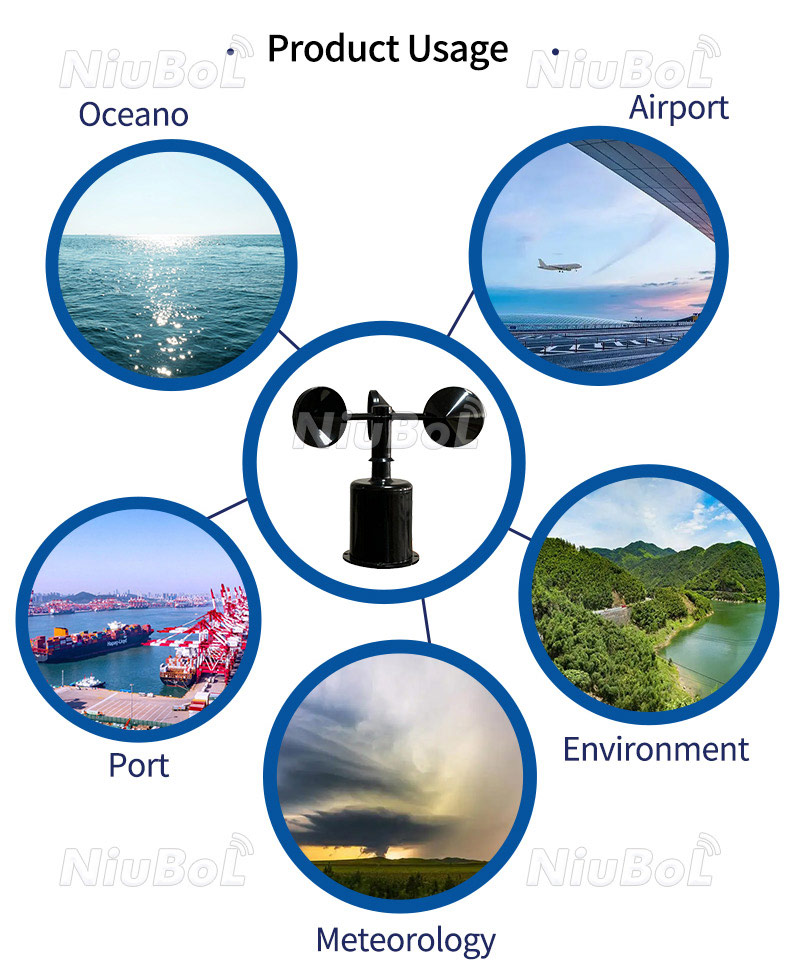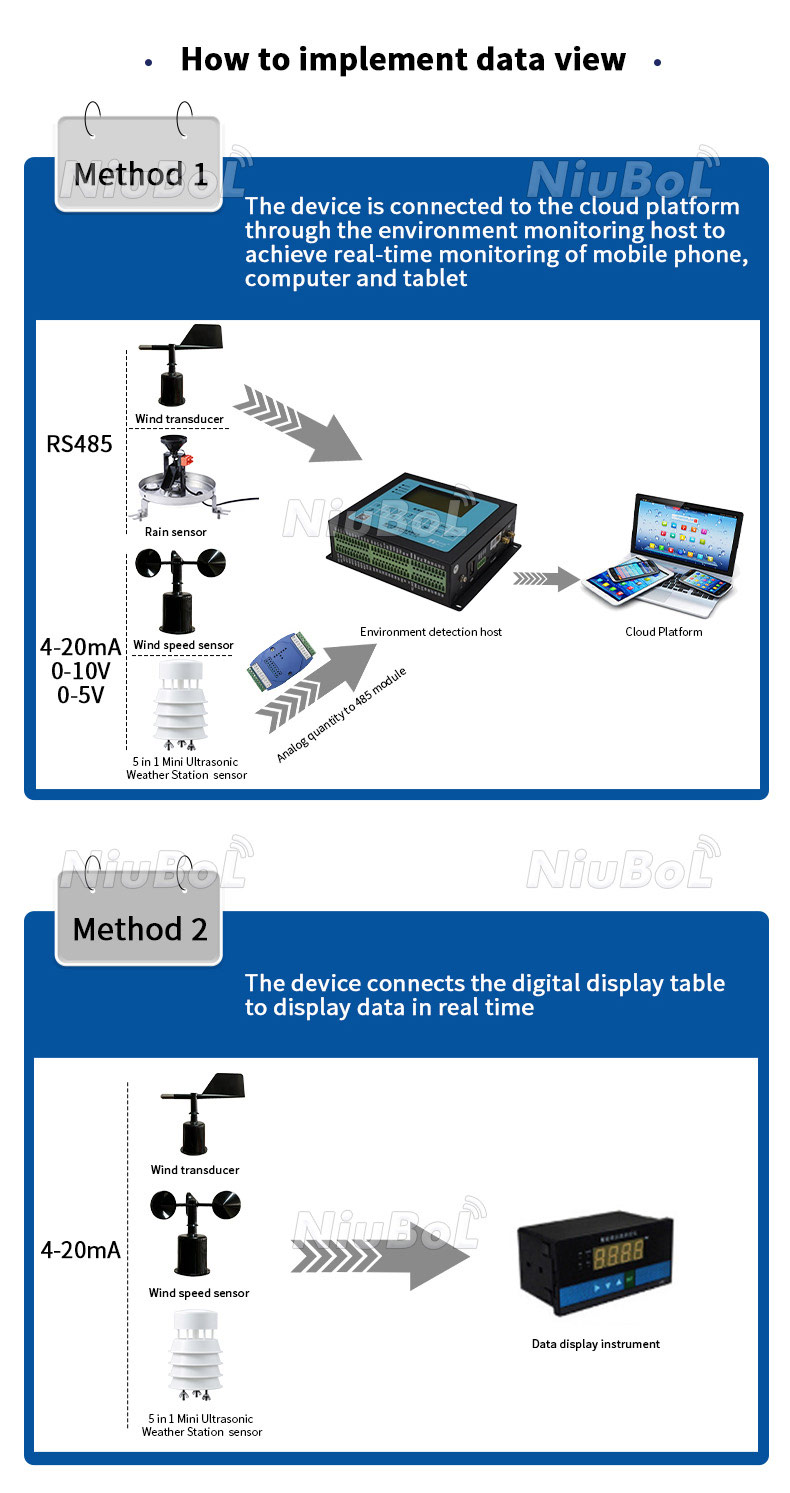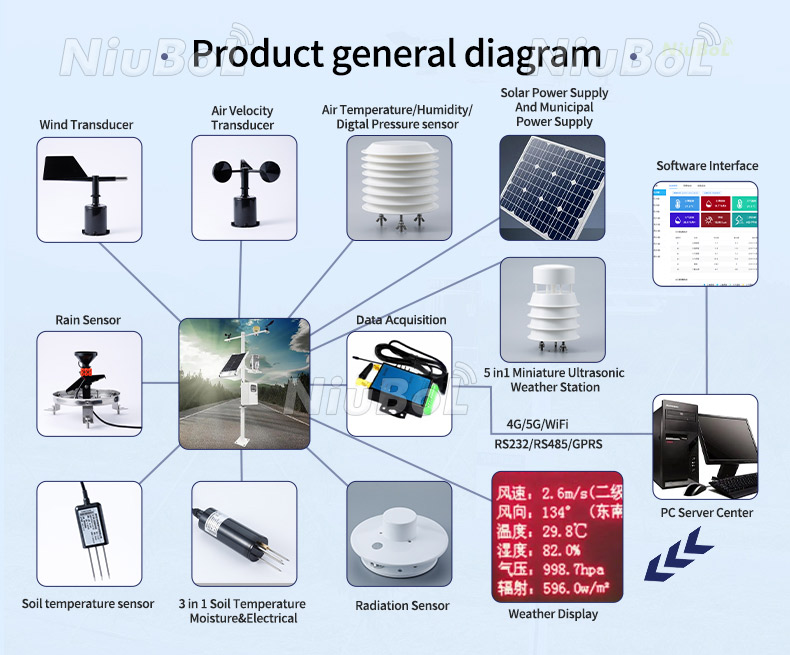

— Blogs —
—Products—
 Consumer hotline +8618073152920
Consumer hotline +8618073152920 WhatsApp:+8615367865107
Address:Room 102, District D, Houhu Industrial Park, Yuelu District, Changsha City, Hunan Province, China
Product knowledge
Time:2024-06-30 21:55:16 Popularity:1591
Wind speed sensors operate based on various principles depending on their type and technology, each offering distinct advantages in terms of accuracy, durability, and suitability for different environmental conditions and applications. Here's a detailed explanation of how some common types of wind speed sensors work and their respective applications:
1. Ultrasonic Wind Speed Sensor
Ultrasonic wind speed sensors use a pair of ultrasonic transducers to transmit and receive ultrasonic pulses. These transducers are typically arranged orthogonally (perpendicular). The instrument measures the time required for ultrasonic pulses to travel between the transducer pairs in different directions. When wind blows, it predictably affects the propagation time of these pulses based on the speed and direction of the wind. By analyzing these time differences, the anemometer calculates wind speed and direction. Ultrasonic wind speed sensors are advantageous because they have no moving parts, which enhances reliability and reduces maintenance requirements.
Principle of Operation Ultrasonic Wind Speed Sensor:
- Utilizes the time-of-flight method of ultrasonic waves for wind speed measurement.
- Sensor probe area equipped with 2 pairs of ultrasonic probes (typically arranged in a cross formation).
- Wind speed is calculated by measuring the transmission time difference between two points.
- This method avoids the impact of temperature on the speed of sound.

Ultrasonic Wind Speed Sensor Applications:
- Meteorological observations: Provides accurate data for meteorological observations, aiding in wind farm site selection and optimizing energy production efficiency.
- Marine applications: Measures sea surface wind speeds, supporting marine meteorology, ocean engineering, and marine scientific research.
- Airports and ports: Provides accurate wind direction and speed data for aircraft takeoff and landing, vessel navigation, etc.
2. Cup Anemometer (Mechanical Wind Speed Sensor)
Cup anemometers consist of several cups (typically three or more) mounted on horizontal arms connected to a vertical pole. When wind blows, it causes the cups to rotate around a vertical axis. The rotational speed is proportional to the wind speed. These cups are calibrated so that the rotational speed can be converted into a measurement of wind speed. Modern cup anemometers often use electronic sensors to count rotations and convert them into digital wind speed readings.
Principle of Operation Cup Anemometer:
- Air flow generates force that drives sensor rotation.
- Central shaft drives internal sensing elements to generate pulse signals.
- Within the wind speed measurement range, wind speed is in a linear relationship with pulse frequency, allowing wind speed to be calculated.

Cup Anemometer Applications:
- Laboratory and industrial applications: Used for research and control of gas flow rates, such as measuring airflow for experimental research.
- Agricultural production: Monitors farm environments and crop growth, providing meteorological support for agricultural production.
3. Hot Wire Anemometer (Thermal Wind Speed Sensor)
The principle of a hot wire anemometer involves using a very fine wire, typically made of platinum, tungsten, or constantan, heated electrically to a constant temperature above the ambient temperature. When air flows over the wire, it cools the wire, causing a change in the wire's resistance. The amount of cooling is directly related to the airflow velocity. By measuring the change in resistance, the instrument can calculate wind speed. This type of wind speed sensor is highly sensitive and can accurately measure very low air velocities.
Principle of Operation Hot Wire Anemometer:
- Based on the relationship between the rate of heat dissipation of the hot wire (or hot film) in the airflow and wind speed.
- The hot wire (or hot film) is heated to a certain temperature. When wind blows, the rate of heat dissipation changes, altering its resistance value.
- Wind speed is calculated by measuring the change in resistance.
Hot Wire Anemometer Applications:
- Meteorological research: Used for precise measurement and analysis of meteorological data.
- Specific industrial environments: Used in scenarios requiring high-precision wind speed measurement.


4. Pitot Tube Anemometer (Dynamic Pressure Wind Speed Sensor)
Principle of Operation:
- Determines wind speed by measuring the pressure difference between a central tube (static pressure tube) and a lateral opening tube (dynamic pressure tube).
- This pressure difference is proportional to the square of the wind speed.
Applications:
- Meteorological observations: Provides data support for meteorological observations, particularly suitable for measuring wide range wind speeds.
- Aircraft: Wind speed measurement on aircraft such as airplanes and helicopters to ensure flight safety.
In summary, different types of wind speed sensors have their own advantages and limitations. The choice of sensor depends on specific application requirements and environmental conditions.
NBL-W-SS-Wind-Speed-Sensors-Instruction-Manual-V4.0.pdf
NBL-W-DS-wind-direction-sensor-Manual.pdf
NBL-W-51MUWS-Ultrasonic-Integrated-Weather-Sensor-Instruction-Manual.pdf
Related recommendations
Sensors & Weather Stations Catalog
Agriculture Sensors and Weather Stations Catalog-NiuBoL.pdf
Weather Stations Catalog-NiuBoL.pdf
Related products
 Combined air temperature and relative humidity sensor
Combined air temperature and relative humidity sensor Soil Moisture Temperature sensor for irrigation
Soil Moisture Temperature sensor for irrigation Soil pH sensor RS485 soil Testing instrument soil ph meter for agriculture
Soil pH sensor RS485 soil Testing instrument soil ph meter for agriculture Wind Speed sensor Output Modbus/RS485/Analog/0-5V/4-20mA
Wind Speed sensor Output Modbus/RS485/Analog/0-5V/4-20mA Tipping bucket rain gauge for weather monitoring auto rainfall sensor RS485/Outdoor/stainless steel
Tipping bucket rain gauge for weather monitoring auto rainfall sensor RS485/Outdoor/stainless steel Pyranometer Solar Radiation Sensor 4-20mA/RS485
Pyranometer Solar Radiation Sensor 4-20mA/RS485
Screenshot, WhatsApp to identify the QR code
WhatsApp number:+8615367865107
(Click on WhatsApp to copy and add friends)
